I grew up drinking herbal soup and tonics with a lot of unidentifiable things in it. There were sweet red rounded things (goji berries) and what look like thick tree barks (codonopsis root). While I could name some of them by their Chinese names, I had no idea what I was eating.
Many years back, I took an interest in Chinese herbology and bought heaps of books to study it. It's amazing to read all the health benefits that these herbs provide. I know how first hand how effective they are to my body (I swear by pat chan tong 八珍汤, a bitter herbal tonic for drinking after menstruation, which energised my body like nothing else).
I know that most people only know the herbs by their Chinese name. But for someone who is illiterate in Chinese, I thought its important to know their name in English so that we could read and learn more about it. Here's a list of common Chinese herbs - in English, Mandarin, and Cantonese - that are kept in my fridge:
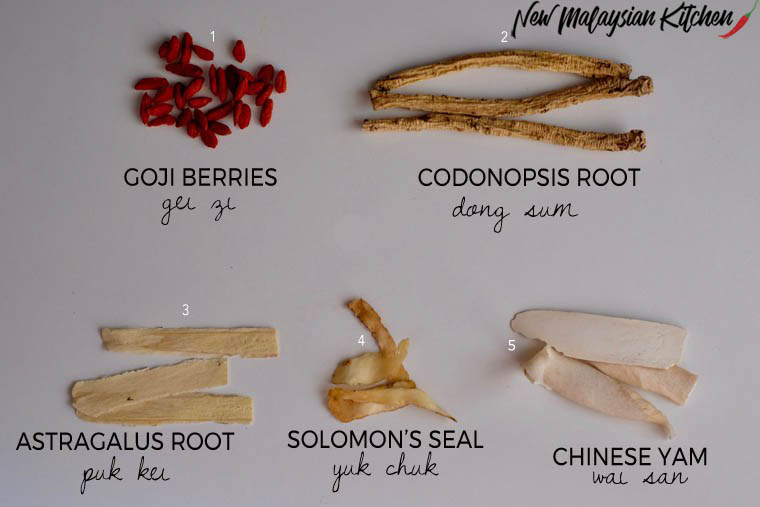
1. Goji Berries - 枸杞子 gou ji zi/ gei chi
2. Codonopsis root - 党参 dangshen/ dong sum
3. Astragalus root - 黄芪 huang qi/ puk kei)
4. Solomon's seal - 玉竹 yu zhu/ yuk chuk
5. Chinese yam - 淮山 huai shan/ wai san)
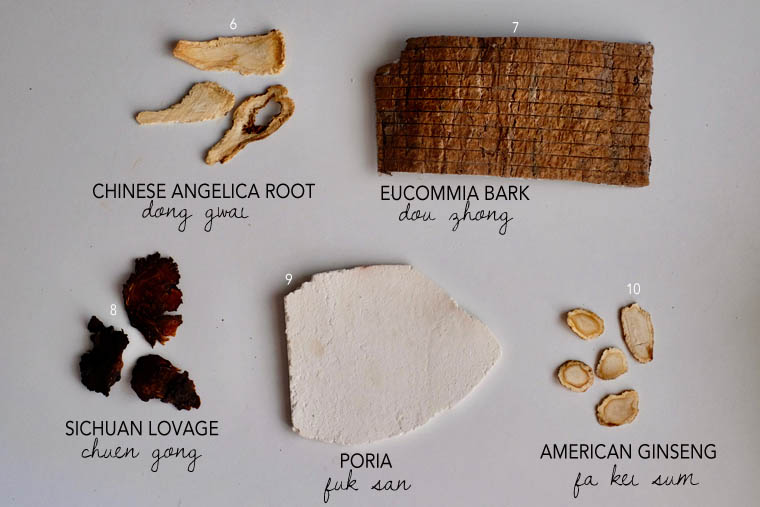
6. Chinese angelica root - 当归 dang gui/ dong guai
7. Eucommia bark – 杜仲 du zhong/ dou zhong
8. Sichuan Lovage - 川芎 chuang xiong/ chuen gong
9. Poria - 茯神 fu shen/ fuk san
10. American Ginseng - 花?參 fa kei sum
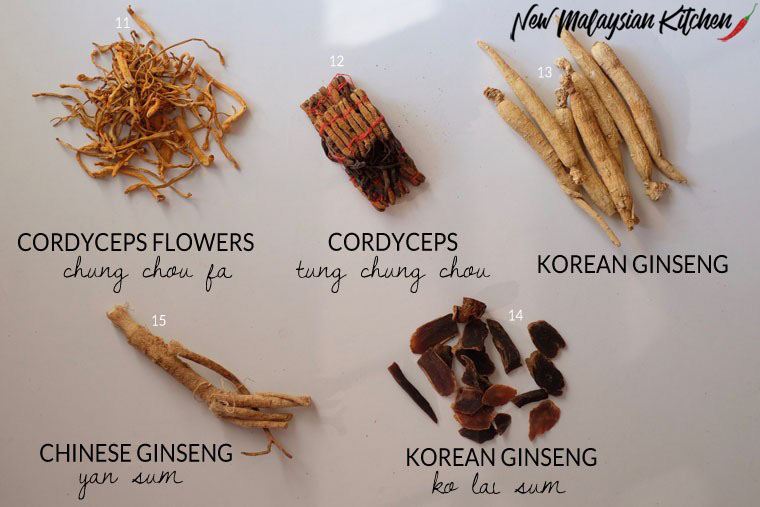
11. Cordyceps flowers - 虫草花 chong cao hua/ chung chou fa
12. Cordyceps - 东虫夏草 dong chong xia cao/ dong chung chou
13. Korean Ginseng - 人参 ren sheng/ yan sum
14. Korean Ginseng - 高麗參 gao li shen/ ko lai sum
15. Chinese Ginseng - 人参 ren sheng/ yan sum
(Note: Both 13 and 14 are Korean Ginseng in different forms)
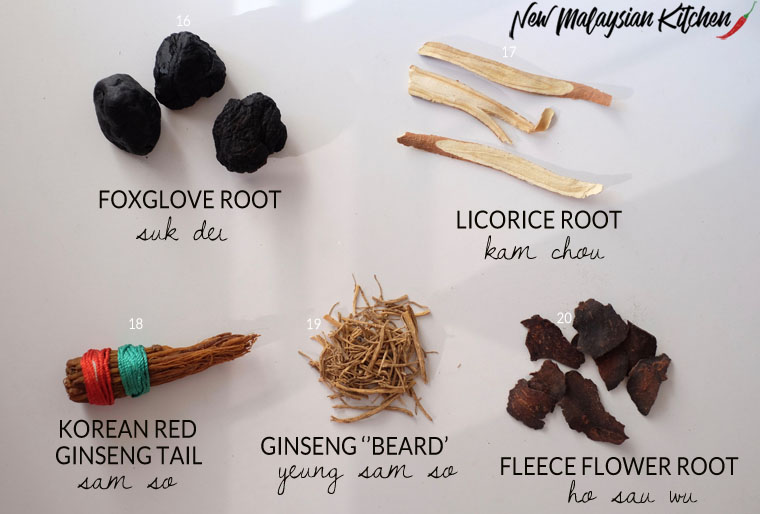
16. Foxglove Root - 熟地黄 shu di/ suk dei
17. Licorice Root - 甘草 gan cao/ kam chou
18. Korean Red Ginseng (Tail) - yeung Sum
19. Ginseng Beard - 洋心须/ yeung Sum So
20. Fleece Flower Root - 何首乌 he shou wu/ ho sau wu
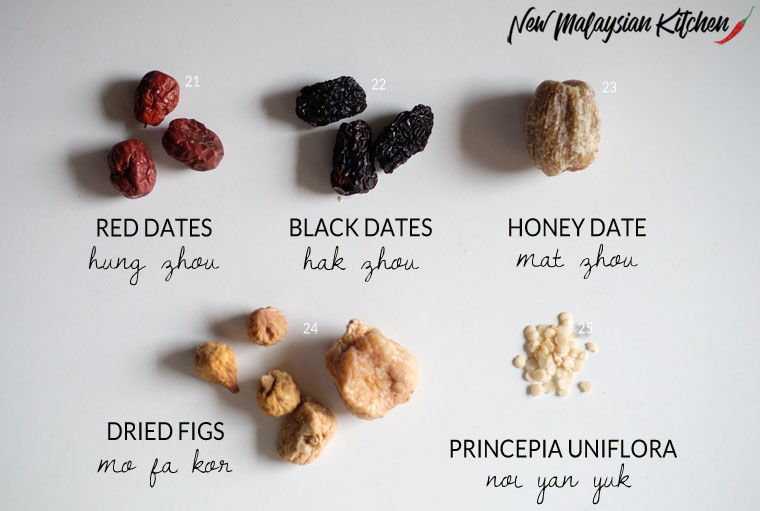
21. Red dates -红枣 hong zhao/ hung zhou
22. Black dates - 黑枣 hei zhao/ hak zhou
23. Honey dates - 蜜枣 mi zhao/ mat zhou
24. Dried figs - 无花果 mo fa kor
25. Princepia Uniflora - 内人肉 noi yan yuk
Many of these herbs are tucked away in the fridge. Due to our hot and humid weather, herbs keep fresh for longer in a cool place.
What other common Chinese herbs that should be in this list? Share with me!
And check out a simple yet potent herbal soup recipe that my mother makes:
FIND THIS USEFUL? GET CURATE RECIPES & FOOD TIPS IN YOUR INBOX
Every month, I send write a personalised e-mail with my favourite recipes, food tips, and recent food adventures. Keep in touch with me by signing-up for my newsletter👇 OR follow me at my personal Instagram.

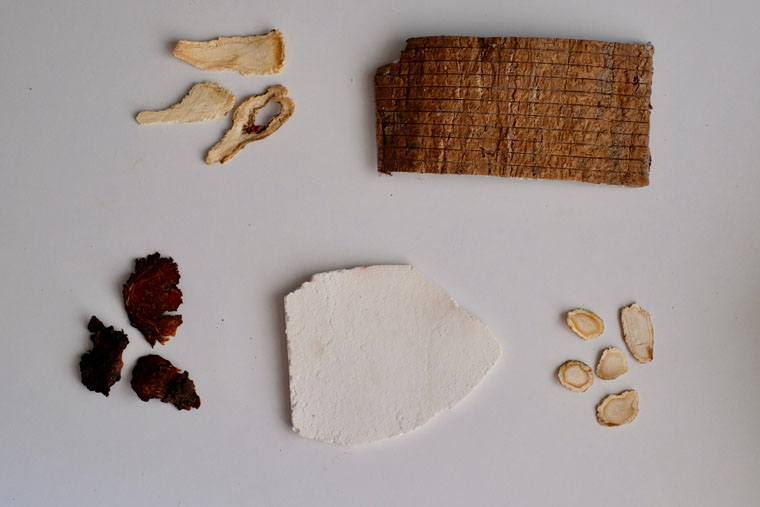
Greetings Sara
Thank you for taking the time to share! I found your post to be fascinating and very helpful.
On another note, I’m interested to know if you have any recommendations for a formula that promotes kidney health? Most recently an ultrasound uncovered a mass on my kidney, of which I am scheduled for a ct scan in the not too distant future. Thus, I am attempting to be proactive in the meantime. Anything you can offer is greatly appreciated!
Hello. Oh dear, hope all will be well. While I read Chinese medicine texts and regularly see a TCM doctor, I am not in a position to recommend you something.
But kudos on being proactive about eating better. Perhaps visit a TCM doctor and ask for recommendation? Or ask a herbalist? In Malaysia, there’s plenty of herbal shops. A popular/commercialised one is https://www.euyansang.com.my Maybe you can find some suitable herbs there and even read some of their articles relating to kidney health: https://www.euyansang.com.my/en_MY/bad-habits-ruin-a-man%27s-kidney/eysmygeneralwellness07.html
Kidney health drink “wandering jew” boil min 4 hours with goji and red dates.
Pingback: Ba Zhen Tong, Chinese Tonic for Women's Health - New Malaysian Kitchen
Thank you for posting this!! I was wondering how can I find “chung chou fa” without knowing the chinese character hahahah. Thanks a lot! ☺☺
You’re welcome! 🙂
I totally relate to your intro on this webpage. Thank you. I can now go shopping for soup ingredients with confidence now. Love the knowledge too. Literally identified Korean ginseng’s, Angelica and liquorice root in this post. They were pieces of wood or roots to me before haha
You’re welcome! Yes, it feels good to be able to identify these herbs and be able to read more about it 🙂
Hi Sara, at the market a Indonesian lady sold me a plant which is similar to curry plant but had a Chinese name : Thona or something ? Do you know that plant. Leaves look like curry leaves.
Thanks
Hi. I have no idea. If you could send me a picture, perhaps I can tell.
Out of curiosity what English books would you recommend on the topic of Chinese herbology? I really love how you had the English, Chinese and English translations of the Chinese words for this page! I also can’t read Chinese and find when I read about this stuff in English I can’t figure out what it is in Cantonese and then when you go to a Chinese herbalist it’s good to have it written out for them to help you buy the right stuff.
Hi Sara,
This resource is fantastic! I also can’t read Chinese and was using your guide to sort out what to buy to make my own Chinese herbal soups at home. Out of curiosity what texts did you purchase about Chinese Herbology? Do any of them have Chinese translations of the items?
Thanks!
Thanks! I bought a few. My favourite is Between Heaven and Earth. Nope, they are without or it would have been easy for me. I took all the herbs out from my fridge, lined them up, and ask my Mom’s help to translate them one by one 🙂
Pingback: Black Chicken Herbal Soup with American Ginseng - New Malaysian Kitchen